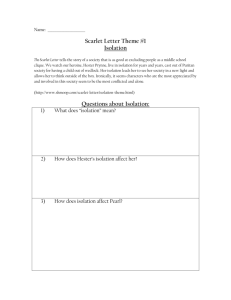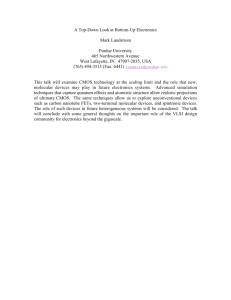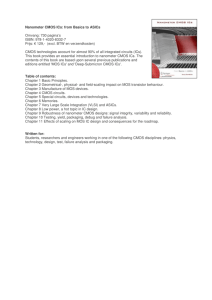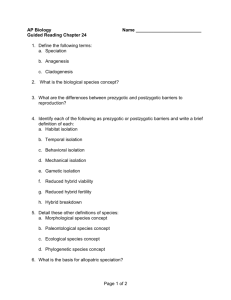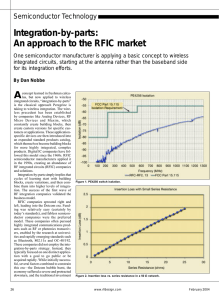Lecture 13 – PROCESS INTEGRATION Chapters 15
advertisement
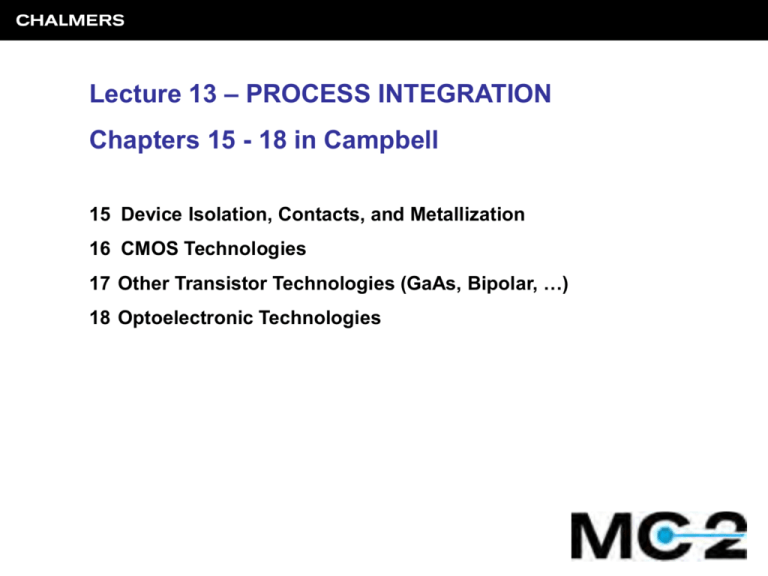
Lecture 13 – PROCESS INTEGRATION
Chapters 15 - 18 in Campbell
15 Device Isolation, Contacts, and Metallization
16 CMOS Technologies
17 Other Transistor Technologies (GaAs, Bipolar, …)
18 Optoelectronic Technologies
DEVICE ISOLATION
More than one component => Some device isolation needed
DEVICE ISOLATION
Isolation by reverse biased PN-junction:
-
Minimum distance between components?
(15.1)
-
Wd = { 2ksε0(Vbi + VCB) / qND } 1/2
(one-sided step junction)
Depletion layers should not meet at max operating voltage
DEVICE ISOLATION
Vt for parasitic surface channel
must be > max operating voltage
What happens at the
surface?
To improve isolation:
• Increase oxide
thickness
• Increase substrate
doping
Guard ring isolation
Effective but:
- Extra process steps
- Consumes area
LOCOS - Local Oxidation of Silicon
•
Selective growth of thick oxide between active components
TRENCH ISOLATION
Etch a trench to provide isolation
-
Deep or shallow depending on requirements
-
Add doping if needed to kill leakage
-
Fill trench with SiO2 and/or poly-Si
-
Planarize by etch-back or CMP (Chemical Mechanical Polishing)
CMP (CHEMICAL MECHANICAL POLISHING)
•
Chapter 11.2 in Campbell
•
CMP extensively used for planarization of multi-level interconnects
•
CMP also used to planarize after trench-fill for isolation
DEVICE ISOLATION
Isolation by using insulating substrate:
SOI - Silicon On Insulator
Thin Si layer (few um) on SiO2 on thick "handle" Si-wafer
GaAs:
Possible to make semi-insulating GaAs substrates
Active devices on mesas ("islands")
Use ion implantation (protons) to create damage
high resistance for device isolation
MESA ISOLATION
CONTACTS
Two types of contacts:
•
Schottky
Ideally "perfect" diode:
No leakage in reverse direction
Low resistance in forward direction
•
Ohmic
Ideally:
Linear I-V curve both directions
Low resistance
SCHOTTKY CONTACT
A low doped semiconductor + metal can form Schottky contact
Øm = Metal work function
Øs = Difference between Fermi level and vacuum level
N-type: Schottky if Øm > Øs
P-type: Schottky if Øm < Øs
Ideally: Barrier = | Øm - Øs |
Imperfections at interface => Effective barrier Øb
I = I0 {exp (qV/nkT) -1 }
I0 = RT2 A exp (- Øb/kT)
OHMIC CONTACTS
Highly doped semiconductor => Tunneling dominates
=> Ohmic contact (no diode)
•
Required doping approx 1018 - 1019 /cm3
•
Ion implantation or diffusion doping (Si)
•
Alloyed contacts (GaAs, other III-V)
METALLIZATION
(Interconnects)
Connect devices or bond pads
•
Low resistance
•
High packing density
Multi-level metallization
Planarization
Damascene process
ILD = Inter Level
Dielectric
32 nm technology, Intel, IEDM, Dec 2008
DEVICE TECHNOLOGIES
Chapters 16, 17, 18 in Campbell
CMOS and other silicon technologies
GaAs and opto devices
Moore's Law
CMOS future development
MOS = Metal Oxide Semiconducor
• NMOS = N-channel MOS, PMOS = P-channel MOS
CMOS = Complementary MOS
• CMOS process more complex but has lower power consumption =>
Now the dominant silicon technology (computers, mobiles, …)
• Current only flows during switching
Power ~ n x freq/2 x Cnode x V2swing
n = average number of gates switching
• MOS-transistor is a 4-terminal device
Source
Drain
Gate
Substrate
Basic 3 um CMOS process
Mask layers
1.
2.
3.
4.
5.
6.
7.
8.
9.
N-well
Active Area
P-minus (field implant)
Poly
P-plus
N-plus
Contact openings
Metal
Bond Pad openings
3 um CMOS process
3 um CMOS process
3 um CMOS process
3 um CMOS process
3 um CMOS process
CMOS – Device scaling
•
Constant field scaling
•
Constant voltage scaling
Main reasons for scaling:
•
Packing density
•
Speed
INTEL, 2014
Intel's 22nm technology
Vertical fins of tri-gate transistors passing through the gates
Silicon Bipolar Technologies
•
Simple Bipolars using ”CMOS-like” process
•
Reduce collector resistance by ”buried collector” (need epi-reactor)
•
Add poly-emitter to increase gain
•
BiCMOS process combines CMOS and Bipolar on same chip
Manufacturing of Ge-bipolar transistors (1961)
GaAs and other III – V technologies
•
No insulating oxide
•
MESFET => Schottky contact on gate
•
Can use semi-insulating high-resistivity substrate
•
High electron mobility => high speed devices
•
Direct bandgap => opto devices
VT= Vbi – qNdd2 / (2kGaAs ε0)
(17.1 & 17.2)

